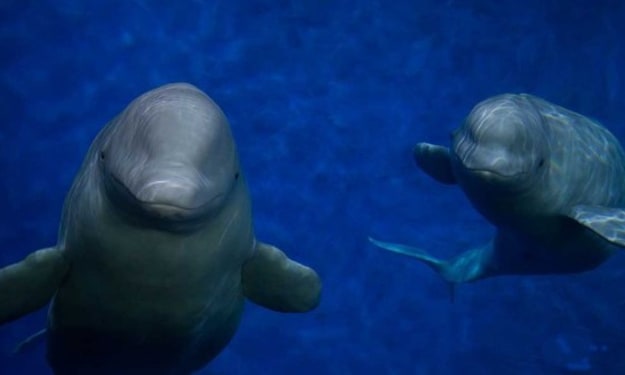
Jenna Deedy
Bio
Zoo and Aquarium Professional, Educator, Cosplayer, Writer and B.A. in Psychology whose got a lot to share when it comes to animals, zoos, aquariums, conservation, and more.
Instagram: @jennacostadeedy
Stories (137/0)
New Calf Born to L-Pod
During a routine survey done on the endangered Southern Resident orca community on Friday, a newborn calf was spotted alongside its mother and family, which made it become the first calf to have been successfully born into the population in over three years.
By Jenna Deedy5 years ago in Petlife
Dolphins Like TV?
Dolphins are known to one of the very few animal species that demonstrate behavioral traits that resemble that of humans. These include establishing complex relationships with other animals, accomplishing common goals, teaching each other basic survival skills that are needed to survive out in the ocean, and even helping out with caring for each other's calves. However, recently, a group of researchers based in Key Largo recently discovered a way on how to enrich dolphins in human care when they are not playing with toys, nor doing public and private training sessions with their trainers—by simply watching a little bit of TV (no joke here).
By Jenna Deedy5 years ago in Petlife
Update on Morgan's Calf: How Is She Doing?
On September 22, 2018, Morgan, a 10-year-old rescued killer whale at Loro Parque, gave birth to a healthy female calf. Although Morgan proved to be a good mother and had exhibited signs of bonding with her newborn daughter, she was not producing enough milk to meet her nutritional needs. So, in response to that concern, the Loro Parque staff stepped in to hand-rear her. The staff consisted of a team of trainers, experts, veterinarians, and marine animal care specialists who continue to monitor the yet-to-be-named calf around the clock on a daily basis and so far, these efforts are proving to show positive signs of her thriving.
By Jenna Deedy5 years ago in Petlife
How Utah’s Clever Fish Conservation Efforts Might Save Southern Resident Orcas in Washington State
Last Tuesday, Utah's Division of Wildlife Resources posted a short video on its Twitter page that depicts conservationists raining dozens of tiny fish from the underbelly of an aircraft into one of the state's high-mountain lakes. The conservationists say that the fish, which usually measure around one to three inches long, tend to survive the fall around 95 percent of the time. In fact, the fish are deliberately released around that small size to ensure that the animals would survive the fall, which to most people would prove to a deadly one.
By Jenna Deedy5 years ago in Petlife
Merlin Entertainment's Beluga "Sanctuary" Raises Eyebrows
In 2012, Merlin Entertainment, a company that specializes in family-oriented business venues like SeaLife Center, LEGOLAND, and Alton Towers, bought Changfeng Ocean World in Shanghai, China. Five years later, the company announces that it was going to team up with the anti-zoo group Whale and Dolphin Conservation (WDC), to transport Changfeng's two female belugas from China to Iceland, where they would live in a sea pen next year. The sea pen, which is being advertised by Merlin as "the world's first beluga sanctuary," has been raising a lot of eyebrows among the marine zoological community in regards to both the welfare of the animals in question, and the hypocrisy of animal rights extremists.
By Jenna Deedy5 years ago in Petlife
Dear Canada, a Ban on Cetaceans in Human Care Won't Save Marine Mammals
Recently, Canada's Senate has passed a bill dubbed as "Bill S-203," which would outlaw the keeping of cetaceans in human care for almost any given purpose. While Marineland Canada and Vancouver Aquarium, the two Canadian zoological facilities that currently house cetaceans would be exempted from this ban, the harm it would have on zoos and aquariums that currently house and care for cetaceans and other marine mammals, as well as efforts to save wild cetacean populations in Canada, is unimaginable in so many ways. However, since the Senate has passed this bill, its next step would be for it to pass through House before being signed by Canada's governor general.
By Jenna Deedy6 years ago in Petlife
Activists Target Florida with New Orca Breeding Ban
A group of radical animal rights extremists under the Animal League Defense Fund, via Representative Jared Moskowitz, have managed to get an amendment that would ban Florida-based zoos and aquariums from possibly housing, or breeding killer whales in their care. The bill, which was heavily inspired by a biased documentary called Blackfish, was originally drafted for the 2018 legislative session, but luckily, at the time, it was never voted on. A year later, these extremists are back with the bill by demanding the public to have it voted for next year's session. Extremists claim that the bill is "animal-saving" when in reality, it would do more harm than any good and there are a number of problems with these breeding "bans" when they are used as legislative methods to control the zoological community.
By Jenna Deedy6 years ago in Petlife
Pollution Could Kill Half of the World’s Wild Orca Populations
Around the world, many wild orca populations are affected by pollution caused by man-made toxins. These toxins are made of various chemicals that often are used on land for different purposes, only to end up in waterways through runoffs before making their way into the ocean as a form of pollution. These various chemicals include flame retardants, industrial pollutants, oils, and pesticides, and they have all been known to enter into oceanic waters through waterways and are now, having a major impact on marine wildlife, including the orcas. Speaking of orcas, a new study has recently confirmed that half of all of the known wild orca populations could be at risk of dying out as a result of exposure to the effects of toxins and ongoing pollution in various parts of the world.
By Jenna Deedy6 years ago in Petlife
Two More Southern Resident Orcas Are Ailing—and Three Are Pregnant
According to researchers who are focused on the Southern Resident orca population, two more whales are falling ill as a result of the lack of salmon they depend on for their survival. The first animal in question is K25, also known as Scoter. He's a 27-year-old adult male who has been documented in aerial photographs for the last decade. Researchers say that in recent weeks, Scoter has been showing signs of becoming thinner than he was in previous years. The trouble for the endangered mammal began last year when his mother, K13, also known as Skagit, died. This is because Skagit, like all orca matriarchs within the Southern Resident pods, helped her family and other pods in navigating the Salish Sea for salmon before capturing and sharing the newly caught prey. Male orcas rely on help from their mothers, sisters, female cousins, nieces, and aunts to find and track down prey and meet their much larger energy demands. Studies have shown that adult orca males tend to have higher risks of dying following their mothers' deaths. This puts Scoter at a higher risk of dying.
By Jenna Deedy6 years ago in Petlife
Morgan, a Rescued Killer Whale Gives Birth at Loro Parque
Morgan, an 11-year-old killer whale who resides at Loro Parque has kicked off the first day of fall by giving birth to her first calf yesterday morning (Spain's local time). According to her trainers and veterinarians, the newborn calf healthy, but are having trouble determining its gender, due to Morgan being very protective of it. This is because the second the calf came into the world, Morgan proved herself to be an excellent mother by attending to her newborn. However, the animal care staff at Loro Parque will continue to monitor the pair in case they need to intervene if things are to go wrong between mother and calf.
By Jenna Deedy6 years ago in Petlife
Will an Agreement to Save Wild Salmon Be Enough to Save Wild Orcas?
In some of my previous articles, I have discussed the plight of the Southern Resident orca community and how the loss of their major food source, the Chinook salmon, is linked to their potential extinction. In addition, I have also discussed the tragic fate of one of these animals in question. A juvenile orca by the name of J50, who was also known as Scarlet. However, with all efforts to save Scarlet from becoming another mass extinction casualty having to have since failed, all eyes have now been turned on preventing future deaths relating to starvation which now means, focusing on saving the salmon that the whales depend on for their survival.
By Jenna Deedy6 years ago in Petlife
Obituary: J50, Also Known as Scarlet
J50, also known as Scarlet, is now believed to have died from an illness relating to malnutrition after researchers off the coast of Washington state were unable to find her among a super pod gathering of all the whales from the Southern Resident community on Thursday. All search efforts to find the animal by boat, plane, and from shore came up with no sight of the four-year-old orca. She was last sighted on September 7th, but the search still continues.
By Jenna Deedy6 years ago in Petlife













